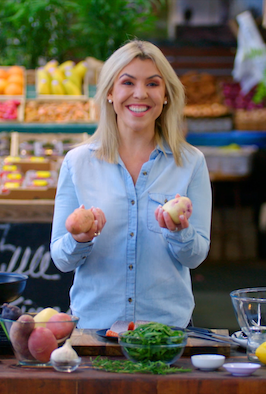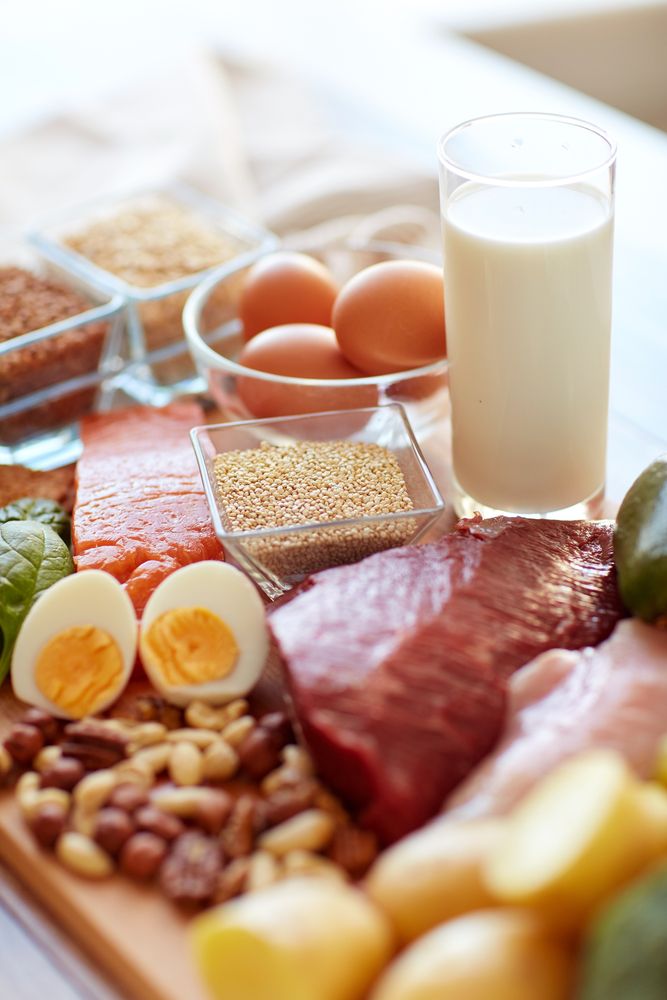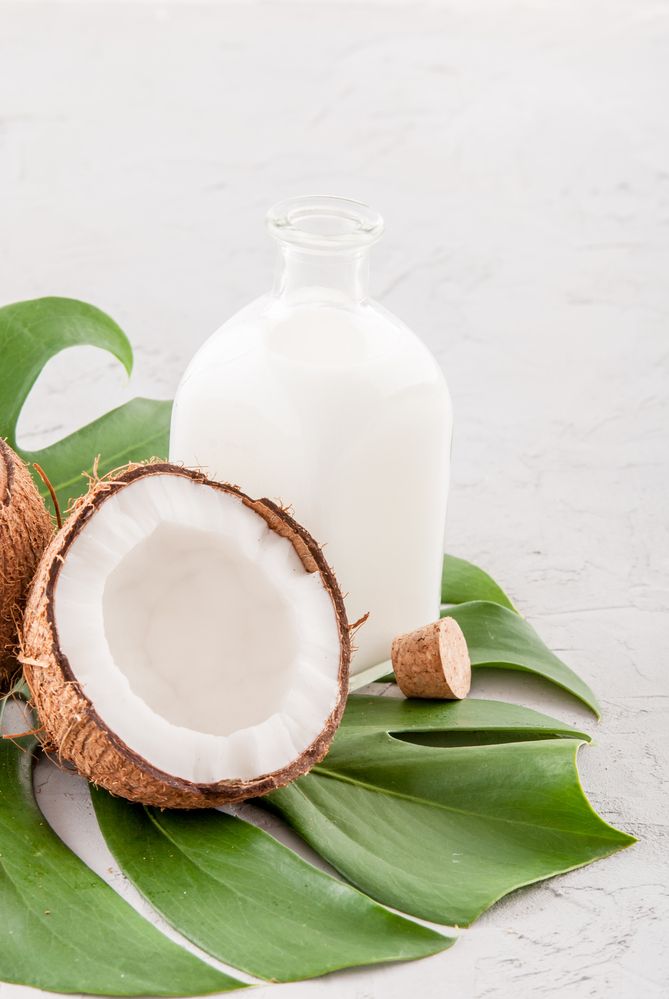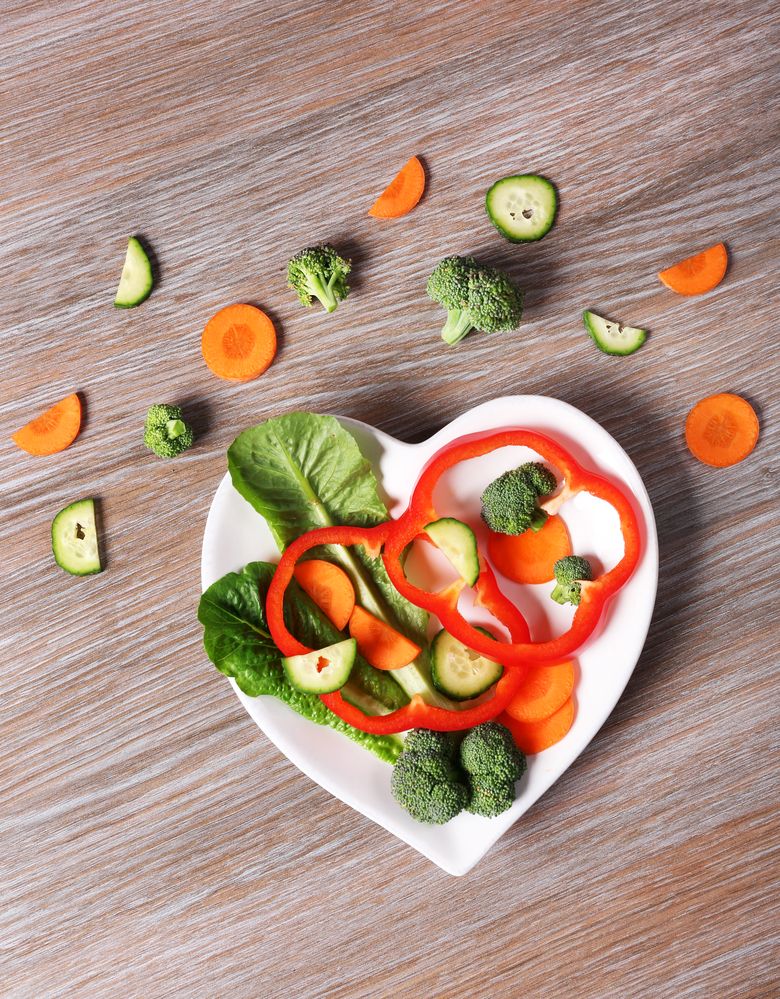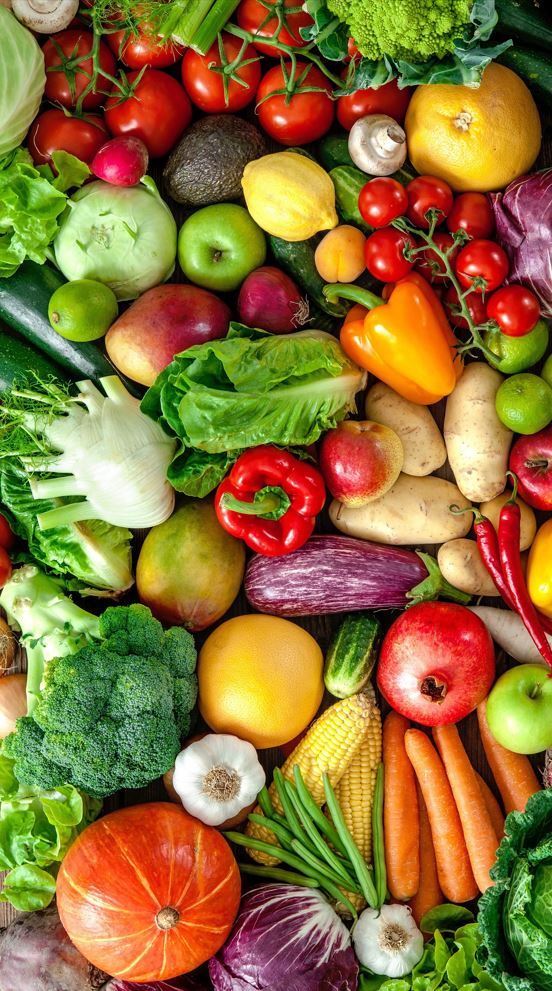Product review: Healthy Life Food Tracker
Written by Catherine Saxelby
on Wednesday, 06 April 2022.
Tagged: health, healthy eating, healthy lifestyle, nutrition, Product review, review
When I was first asked to write this review, I thought, Not another tracker.
After all, there have been several in recent years, such as My Fitness Pal and Everyday Diet Diary. But this one is different. It works by using your Everyday Rewards card AND your shop at Woolworths.
This post has been sponsored by healthylife 
What is it?
Healthylife Food Tracker is a free tool to help you achieve a more balanced diet. Developed in partnership with Woolworths, it helps you assess the balance of foods that make it to your plate, based on the groceries you buy. It shows you your shopping patterns over time, which helps you become aware of your shopping habits and inspires you to make healthier food choices.
If you shop for some items at other stores or markets, the tracker won’t capture this information, so bear in mind that it may not give you a complete picture of your household’s food intake.
To help solve this, you simply estimate how much you shop at Woolworths (from 0% to 100%) and the tracker does the rest. When testing, I applied from 50% to 75% across the categories, because I have two Woolworths stores near me and shop there quite a lot. It’s a near-enough estimate.
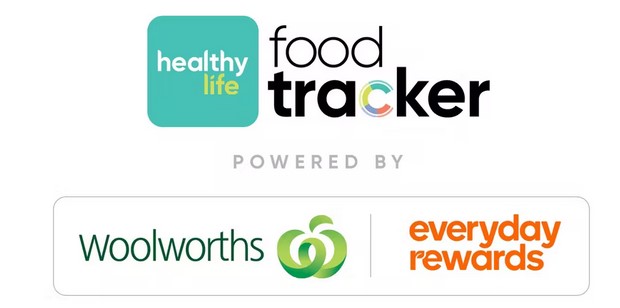
The Food Tracker
Once you click Get Started (under the healthylife Food Tracker logo), you select:
-
The number of people in your household (I chose two).
-
The percentage of shopping you do at Woolies. I allocated my Woolworths shopping as follows:
50% for Vegetables & Legumes
75% for Fruits
75% for Dairy & Alternatives (e.g. milk, cheese, yoghurt)
50% for Meat & Alternatives
75% for Grains (e.g. bread, rice, pasta)
You choose in increments of 25% from 0% to 100%.
You can also select whether you shop Weekly, Fortnightly (this is what I chose) or Monthly. This gives you the most representative view and lets you get the most out of Food Tracker.
A bar chart shows you the five main food groups: Vegetables & Legumes, Fruits, Dairy & Alternatives, Meat & Alternatives, and Grains. ![]()
The chart shows how many serves you need to consume over the next seven days (from your last shop) across the five main food groups to reach your recommended targets. These are based on the Australian Dietary Guidelines and Australian Guide to Healthy Eating for the total household number you entered.
The chart also shows the proportion of your shop among these five food groups, and between Main Food Groups and Sometimes Foods & Drinks (discretionary items). Luckily for me, mine showed 83% from the Main Food Groups, with only 17% from Sometimes Foods & Drinks. The average for the Aussie population, however, is about 33% from Sometimes Foods & Drinks.
![]()
You can see the balance of your shop, letting you know how many serves of food from each food group you’ve already consumed and how many you’ve got left for that week or fortnight.
![]()
The app has handy little pop-ups to explain what everything means. For example, I clicked on a pop-up explaining that my household shopping was being compared to the serves recommended in the Australian Dietary Guidelines. By clicking on the link, you’re taken straight there to read more.
![]()
Overall, the app was clear and easy to use. I really liked that it worked out how many serves I’d eaten and showed me how many more I needed to eat to reach my goals.
The app recommended that I enrol in one of their short five-day health programs about sugar management. With these, you sit back and let healthylife deliver a wealth of knowledge to you. All you have to do is keep engaged and you’ll reap the benefits. Your goal is to understand the real facts about sugar and boost your nutrition by eating fewer “added” sugar foods. The incentive? You’ll receive 200 Everyday Rewards points.

On the site
The website healthylife.com.au contains many things to do with nutrition. For instance, there are the three popular programs, such as “Eat more veggies”, “Manage sugar intake” or “Move more”. Under Learn, you’ll spot five lessons:
- Fitness
- Food & Nutrition
- Health
- Lifestyle & Wellbeing
- Looking Good.
If I click on Food & Nutrition (a fave of mine), there are posts covering “What’s in season in autumn for a low FODMAP diet” and “Autumn low FODMAP fruits”. As part of Food & Nutrition, I can select Diet, which offers me recent posts on “Going for grains!” and “The perks of a well-stocked pantry”.
Diet
In this section, you’ll see posts such as “7 easy ways to turn pantry staples into a meal (or snack)” and “The difference between a plant-based diet and vegan”. There are also posts on:
- Kids’ Nutrition
- Low FODMAP Diet
- Healthy Weight
- Plant-based Eating.
![]()
Shop
Here you'll find a wide range of products including health foods, personal care & beauty, vitamins and supplements, eco-friendly household products plus a whole lot more. For more, go to https://www.healthylife.com.au/shop
Programs
Here, you’ll read about the small, achievable changes you can make to live a healthier life. If you’re like most people, you probably have super-good intentions when it comes to living healthy but, sometimes, it just feels too hard. That’s why they’ve created Ways to Well, a series of programs to help you make small easy changes. There’s a financial incentive, too; you collect 200 Everyday Rewards points when you complete a healthylifeHealthy Life program.
Book a call
You can also have a discovery call with a health professional from their in-house health team for healthy eating advice, how to choose the right product or a bit of guidance on where to turn for health information.

Overall score: 45 out of 50 or 4.5 apples
Sign up to Food Tracker now: Click here
The final word
This is a great site, plus you get the handy Food Tracker. If you shop regularly at Woolworths, it’s worth signing up because it’s so convenient. It’s good to see bigger companies employing dietitians and dietetic organisations to write the posts and programs.
Reviews
-
Read more
Product review: Low-sugar alcoholic ginger beer
1 March 2023 by, Catherine Saxelby
Want something to drink before dinner? Something that’s LOWER in alcohol than wine? To match his beer? Then look no further than Bundaberg’s low-sugar alcoholic ginger beer.
You can drink Bundaberg low-sugar ginger beer straight from the can, or pour it into a long glass over ice with a slice of lime.
-
Product snapshot: Berkelo’s Khorasan Macaroni
14 September 2022 by, Catherine Saxelby
I’m loving this macaroni from Berkelo. I was sent a sample for Whole Grain Week 2022 by the Grains Legume Nutrition Council. I cooked it up and found that it was just divine! Read on for more …
-
Product review: Super high-oleic safflower oil
11 May 2022 by, Catherine Saxelby
“What does super high-oleic mean?” I hear you ask. Also, “I haven’t heard of safflower for ages. What’s the deal?” Read on and all will be explained.
-
Product review: Healthy Life Food Tracker
6 April 2022 by, Catherine Saxelby
When I was first asked to write this review, I thought, Not another tracker.
After all, there have been several in recent years, such as My Fitness Pal and Everyday Diet Diary. But this one is different. It works by using your Everyday Rewards card AND your shop at Woolworths.
-
20 October 2021 by, Catherine Saxelby
With home delivery on the rise, this post is reviewing none other than that stalwart Lite n’ Easy. We all know their meals are good for weight loss (which we all need after COVID-19!), but did you know they’re also good for general health and wellbeing ? Eating well to nourish yourself – putting your mental health and wellbeing at the forefront – is gaining momentum. Lite n’ Easy meals also ensures you satisfy your need for vitamins, minerals, fibre and phyto-compounds, such as sterols and carotenoids.
 This post has been sponsored by Lite n' Easy.
This post has been sponsored by Lite n' Easy. -
Product review: Birds Eye Plant Based range
15 September 2021 by, Catherine Saxelby
When you think of Birds Eye, their frozen peas and fish fingers probably come to mind. But I bet you’d never think of plant-based products!
 This post has been sponsored by Birds Eye.
This post has been sponsored by Birds Eye. -
Product Snapshot: Olina’s Snackers Crackers
2 June 2021 by, Catherine Saxelby
We sampled Olina’s latest offering in the seeded cracker range – called Olina’s Bakehouse Seriously Seedy Snackers (which is a great name BTW). They come in four flavours: Barbecue, Chilli & Lime, Beetroot & Sour Cream, and Balsamic Vinegar & Caramelised Onion. Take a look at our verdict.
Healthy Weight Loss
-
Read more
Intermittent fasting vs daily calorie restriction
3 May 2023 by, Catherine Saxelby
As you probably know already, intermittent fasting (IF) has gained favour as an alternative regimen to daily caloric restriction (DCR). Fasting is shown to extend the lifespan of rats, and has been associated with metabolic benefits in humans, yet the results so far have been inconsistent. So, which regimen is best for healthy weight loss?
-
15 March 2023 by, Catherine Saxelby
What sort of a diet should you follow to lose that excess weight? These days, it’s pretty confusing with high-protein Keto advocates clashing with plant-protein followers … as well as intermittent fasters, juice-only dieters, no-carb dieters and no-animal (aka plant-based) dieters. Plus all the ads for anti-hunger supplements, meal-replacement shakes and home-delivered meals, more of which somehow appear every day. So, what sort of diet should YOU follow to lose that excess?
-
Protein shakes for weight loss
9 November 2022 by, Catherine Saxelby
These days, protein shakes aren’t bought by just body builders – they’re so popular that you can readily buy a 400 g tub at your local supermarket or service station. And with tempting claims such as ‘Facilitates muscle toning’, ‘Contains transformation-making protein’ and ‘Tastes incredible, mixes easily’, why wouldn’t you grab one? But protein shakes aren’t the magic answer to all your weight-loss woes. Let’s take a look at what you get for your money.
Guest post by dietitian Zoe Wilson APD
-
20 January 2021 by, Catherine Saxelby
Many of us have cravings from time to time and for different reasons. One thing is certain, they can sabotage all your best efforts at a healthy diet and/or weight loss. The good news? You CAN beat them. I’ll tell you how.
-
How to lose weight WITHOUT going on a diet
14 October 2020 by, Catherine Saxelby
The word 'diet' is a turn-off for most people. It sounds hard, unpleasant and unpalatable. Losing weight doesn’t have to be hard AND it doesn’t have mean sticking to a 'diet'. You can forget Paleo, Keto, Vegan and Raw, Gluten-free and Intermittent Fasting. To lose weight, you don’t have to follow any specific diet. What you need is simple, healthy, nutritious food and a few tips and tricks.
-
What IS a healthy balanced diet for weight loss?
16 September 2020 by, Catherine Saxelby
Healthy weight loss happens when you lose weight slowly and steadily (around 1 kg or 2 pounds weight loss a week). Your goal is to lose weight while still getting your essential nutrients but from smaller portions. You certainly don’t want to be tired with no energy! That’s why you need regular healthy meals and snacks on hand to ensure your vitamins, minerals, omega-3s and fibre needs can be easily met. There is a new range of healthy weight loss meals available and it’s one that I’d like to recommend. With these ready meals, you’ll say goodbye to meal planning, shopping, meal preparation and cooking.
This post is sponsored by Chefgood
-
Kitchen make-over for the New Year
8 January 2020 by, Catherine Saxelby
“This year, I'm going to lose weight!”, or “This year I’m opting for a healthier lifestyle!” Is your 2020 New Year's resolution something like one of these? If so, how is it going to happen?
Most popular
-
Read more
Q. What's the difference between Diet Coke and Coke Zero?
12 September 2013 by, Catherine Saxelby
A. At first glance, Diet Coke and Coke Zero appear to be identical. Both contain no kilojoules (Calories) and no sugar. Both are artificially sweetened with (the same amount) of aspartame and acesulfame K and therefore have the same ‘sweetness’.
-
How to convert sodium to salt (and salt to sodium)
6 August 2010 by, Catherine Saxelby
As a nutritionist, my aim is to help busy women eat healthily. One of the ways to do this is to follow the general nutrition advice to reduce the salt in your diet. So, how can you do this when what you’ll see on a food label and on any recommended daily intakes is sodium?
-
7 types of sugar - which is healthier?
11 December 2013 by, Catherine Saxelby
Last week on the radio, the announcer asked me if there was a 'good' sugar – one that would satisfy her sweet tooth but that was 'healthier' than regular white sugar. She figured if there were 'good' carbs and 'bad' carbs there must be some sugars that would get the nod of approval from nutritionists.
-
Eat to beat gastro and diarrhoea
12 October 2012 by, Catherine Saxelby
A clear fluid diet is the best form of treatment for gastro and tummy upsets. It is the "lightest" type of diet, designed to place as little strain as possible on the digestive tract. It is NOT nutritionally adequate and should be followed only for a strictly limited time e.g. two or three days but no more than a week.
-
Nutella. The full (correct) list of ingredients
12 April 2011 by, Catherine Saxelby
Have you ever tried to find the exact list of ingredients for Nutella online? The identical one that appears on its label - in descending order from the first (largest ingredient by weight) to the last ingredient, as required by law? Well, you won’t find it! Here’s the hoop-la I went through to discover exactly what the ingredients in Nutella are and why Nutella is not good for your kids.
-
Sugar - why quitting sugar guarantees you'll lose weight
6 May 2013 by, Catherine Saxelby
Sugar. It's been labelled "deadly", "addictive", "toxic", "sweet poison" and blamed for the rise in global obesity in recent years." Get rid of the white toxin from your diet and you'll free up your body to drop those excess kilos" (or so say anti-sugar campaigners Sarah Wilson, David Gillespie and Robert Lustig). Here are the three real reasons why I believe quitting sugar helps you lose weight.
-
What does 8,700 kilojoules look like?
14 August 2012 by, Catherine Saxelby
8,700 is a magic number in nutrition. It’s the number of kilojoules (kJ) that is the “average” intake for adults in Australia, if the surveys are correct.
It’s widely used as a benchmark figure and as the basis of food labels such as the Percent Daily Intake values.
Recently kilojoules have appeared on fast food menu boards and they use 8,700 as the yardstick to assess their foods against. Here's my take on it.
Recipes
-
Read more
24 May 2023 by, Catherine Saxelby
This is a kind of pavlova topped with fruit, but the base is made from ricotta, rather than egg whites and sugar.
-
22 March 2023 by, Catherine Saxelby
This is an Asian-influenced salad that’s perfect to serve as a side salad at a BBQ or with a fillet of fish.
-
14 December 2022 by, Guest Post
This banana loaf is half bread and half cake. Hence I've called it "cread" which is halfway! It’s dense and delicious without being super-sweet or oily. It can be enjoyed fresh, toasted or sliced and frozen into portions to enjoy later.
-
23 November 2022 by, Guest Post
This quick and easy dessert is ready in minutes. And there are NO leftovers to tempt you later!
-
19 October 2022 by, Catherine Saxelby
A quick and easily-made sandwich, it’s great for an easy lunch.
-
Spring Vegetable Pesto Pasta Salad
7 September 2022 by, Guest post
This super salad-in-one gives you pasta plus vegetables all together. It has a spring feel to it.
-
Squash-ed spaghetti bolognaise
3 August 2022 by, Guest post
This is an excellent make-and-freeze recipe, so weeknight meals become more manageable. I know of no better way of ‘hiding’ veggies than in a Bol sauce – somehow mince with a few veggies like pumpkin or zucchini is a match-made-in-heaven.
Foodwatch
The Good Stuff
The Boring Stuff
© 2025 Foodwatch Australia. All rights reserved
Website by Joomstore eCommerce
